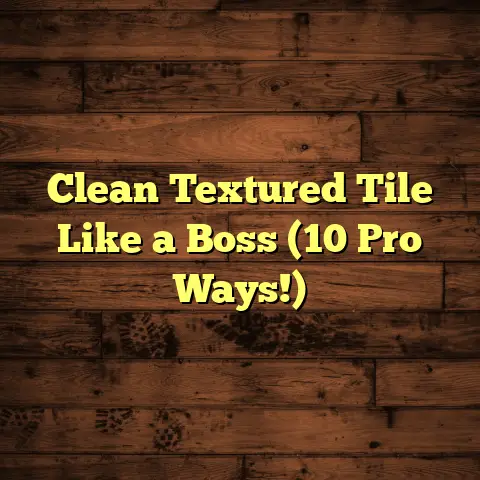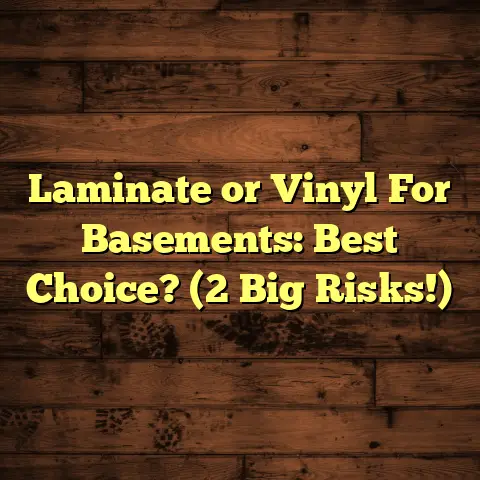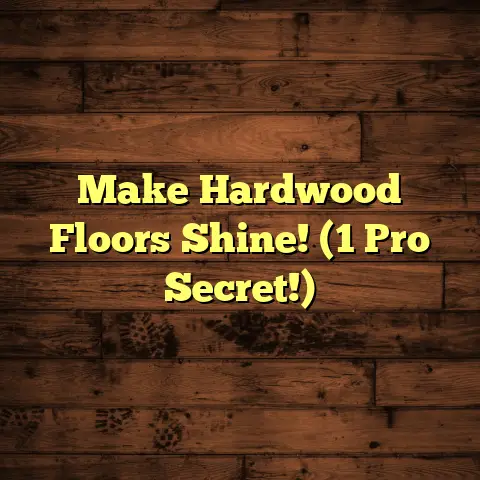Wood-Look Vinyl: Top Flooring? (1 Choice Will Shock!)
(1 Choice Will Shock!)
Introduction: Identifying the Challenge
Choosing new flooring can feel like navigating a minefield, right? I’ve been there with countless homeowners, seeing the glazed-over look as they’re bombarded with options.
Hardwood, tile, carpet, laminate… and then there’s the ever-popular wood-look vinyl. It’s enough to make your head spin!
The market is flooded with choices, each promising the perfect blend of beauty, durability, and affordability. But how do you actually find that sweet spot?
You want something that looks great, can handle the chaos of daily life (kids, pets, spills!), won’t break the bank, and isn’t a nightmare to maintain.
It’s a tall order. So, is wood-look vinyl the answer to all these flooring dilemmas?
That’s what we’re going to explore. I’ll break down everything you need to know, from the nitty-gritty of what it is to the surprising alternative that might just steal its thunder.
Section 1: Understanding Wood-Look Vinyl
Okay, let’s get down to brass tacks. What exactly is wood-look vinyl?
Simply put, it’s a type of flooring designed to mimic the appearance of real hardwood. Think of it as a chameleon, cleverly disguising itself as something more expensive and high-maintenance.
But it’s not just a simple print. The best wood-look vinyl incorporates realistic textures and patterns, making it incredibly difficult to distinguish from the real thing at first glance.
Composition and Manufacturing
Wood-look vinyl typically comes in several forms, the most common being:
- Luxury Vinyl Planks (LVP): These are individual planks that click together or glue down. They offer the most realistic wood appearance and are often thicker and more durable.
- Luxury Vinyl Tile (LVT): Similar to LVP but designed to mimic tile or stone.
- Sheet Vinyl: This comes in large rolls and is a more budget-friendly option. It’s less realistic than LVP but still offers a wood-look alternative.
The manufacturing process generally involves several layers:
- Wear Layer: This is the top layer, providing protection against scratches, stains, and wear. The thicker the wear layer, the more durable the flooring. I usually recommend at least a 20 mil wear layer for high-traffic areas.
- Print Layer: This layer features the high-resolution image of wood grain. Advances in printing technology have made these images incredibly realistic.
- Core Layer: This provides the flooring’s stability and thickness. It’s often made of PVC or a composite material.
- Backing Layer: This bottom layer provides cushioning and helps with sound insulation.
Technological Advancements
The realism of today’s wood-look vinyl is mind-blowing. It’s not your grandma’s linoleum anymore!
Manufacturers use advanced printing techniques, embossing, and texturing to create incredibly realistic wood grains, knots, and even saw marks.
Some high-end options even feature beveled edges, adding to the authentic look and feel. I’ve seen clients do double-takes, convinced they were walking on genuine hardwood.
Section 2: Benefits of Wood-Look Vinyl
Now, let’s dive into the reasons why wood-look vinyl has become such a popular choice.
Aesthetic Advantages
One of the biggest draws is the sheer variety of styles available. You can find wood-look vinyl that mimics virtually any species of wood, from classic oak and maple to exotic hardwoods like Brazilian cherry or reclaimed barn wood.
- Design and Color: The possibilities are endless! Whether you’re going for a rustic farmhouse vibe, a sleek modern look, or a traditional aesthetic, there’s a wood-look vinyl to match.
- Interior Styles: It complements everything from minimalist designs to bohemian spaces. You can easily find a color and texture that ties your entire room together.
Durability and Resilience
This is where wood-look vinyl really shines. Unlike real hardwood, it’s incredibly resistant to scratches, moisture, and heavy foot traffic.
- Pets and Children: Got furry friends or rambunctious kids? No problem! Wood-look vinyl can handle the abuse. Spills wipe up easily, and scratches are far less of a concern than with hardwood.
- Moisture Resistance: This makes it perfect for kitchens, bathrooms, and basements where real wood would be a disaster waiting to happen. I’ve seen homeowners breathe a sigh of relief knowing their floors can handle the occasional splash.
Ease of Maintenance
Forget about sanding, refinishing, and special cleaning products. Wood-look vinyl is incredibly easy to maintain.
- Cleaning: A simple sweep and mop with a mild detergent is all you need to keep it looking its best.
- Stain Resistance: Most spills wipe up without leaving a trace. Say goodbye to worrying about red wine stains or muddy paw prints!
Cost-Effectiveness
Let’s talk money. Wood-look vinyl is generally more affordable than real hardwood, both in terms of materials and installation.
- Installation Costs: Depending on the type of vinyl and the complexity of the installation, it can be significantly cheaper to install than hardwood.
- Long-Term Value: Considering its durability and low maintenance, wood-look vinyl offers excellent long-term value. You won’t have to worry about costly repairs or refinishing down the road.
Section 3: Popularity and Trends
It’s not just me singing its praises. The numbers don’t lie! Wood-look vinyl has seen a massive surge in popularity over the past few years.
Market Trends
According to industry reports, the luxury vinyl flooring market has been growing at an impressive rate.
In fact, a report by Grand View Research projects the global luxury vinyl flooring market to reach $56.86 billion by 2030. That’s a whole lot of vinyl! Grand View Research
This growth is driven by several factors, including its affordability, durability, and aesthetic appeal.
Consumer Preferences
Homeowners are increasingly drawn to wood-look vinyl for its combination of style and practicality. It’s a perfect solution for busy families, pet owners, and anyone who wants beautiful floors without the hassle of maintaining real hardwood.
- Renovations and New Constructions: It’s a popular choice for both renovations and new construction projects. Builders and contractors often recommend it for its ease of installation and long-lasting performance.
Industry Statistics
Surveys consistently show high levels of consumer satisfaction with wood-look vinyl flooring. People love its realistic appearance, its ability to withstand wear and tear, and its easy maintenance.
A survey conducted by Floor Covering News found that 85% of homeowners who installed LVP flooring were “very satisfied” with their purchase.
That’s a pretty strong endorsement!
Section 4: Installation Process
So, you’re sold on wood-look vinyl. Now what? Let’s talk about installation.
Installation Methods
There are several different installation methods available, each with its own pros and cons:
- Click-Lock (Floating): This is the most popular method, especially for DIYers. The planks or tiles simply click together, creating a floating floor that doesn’t need to be glued down.
- Glue-Down: This method involves adhering the vinyl directly to the subfloor with adhesive. It’s more stable than click-lock but requires more prep work and expertise.
- Loose Lay: This is a relatively new method where the vinyl is simply laid on the subfloor without any adhesive or clicking. It relies on the weight and friction of the material to stay in place.
Step-by-Step Overview
Here’s a general overview of the installation process for click-lock LVP:
- Preparation: Ensure the subfloor is clean, level, and dry. Remove any existing flooring and repair any cracks or imperfections.
- Underlayment (Optional): An underlayment can provide extra cushioning, sound insulation, and moisture protection.
- Layout: Plan the layout of the planks, leaving a small expansion gap around the perimeter of the room.
- Cutting: Use a utility knife or a flooring cutter to cut the planks to the correct size.
- Installation: Start in one corner of the room and click the planks together, following the manufacturer’s instructions.
- Finishing: Install baseboards and transition strips to cover the expansion gap and create a seamless finish.
DIY vs. Professional Installation
Can you install wood-look vinyl yourself? It depends on your skill level and the type of vinyl you choose.
Click-lock LVP is generally DIY-friendly, especially for smaller rooms. However, glue-down installations are best left to the professionals, as they require more expertise and specialized tools.
If you’re unsure, it’s always best to consult with a professional flooring contractor. I’ve seen too many DIY projects gone wrong, resulting in costly repairs and wasted materials.
Section 5: Environmental Considerations
In today’s world, sustainability is a major concern. So, how does wood-look vinyl stack up in terms of environmental impact?
Sustainability Aspects
The sustainability of wood-look vinyl depends on the materials used and the manufacturing process.
- Materials: Most wood-look vinyl is made from PVC (polyvinyl chloride), a synthetic plastic polymer. PVC is durable and long-lasting, but it’s also derived from petroleum, a non-renewable resource.
- Manufacturing: The manufacturing process can involve the use of chemicals and energy. However, many manufacturers are now implementing more sustainable practices, such as reducing waste and using recycled materials.
Comparison with Hardwood
Compared to traditional hardwood, wood-look vinyl has both advantages and disadvantages in terms of sustainability.
- Hardwood: Harvesting hardwood can lead to deforestation and habitat destruction if not done responsibly. However, hardwood is a natural, renewable resource, and it can be recycled or repurposed.
- Wood-Look Vinyl: Wood-look vinyl doesn’t require the harvesting of trees, but it’s made from synthetic materials. However, it’s often more durable than hardwood, which means it may need to be replaced less frequently.
Recycling and Certifications
Recycling options for wood-look vinyl are still limited, but some manufacturers are starting to offer recycling programs.
Look for certifications like FloorScore and GreenGuard, which indicate that the flooring has been tested for low emissions and safe indoor air quality. These certifications ensure that the flooring meets strict standards for volatile organic compounds (VOCs), which can be harmful to your health.
Section 6: The Shocking Choice
Okay, here’s the twist you’ve been waiting for! While wood-look vinyl is a fantastic option, there’s another flooring choice that’s been gaining traction and giving it a run for its money: wood-look tile.
Wood-Look Tile: The Contender
Wood-look tile is exactly what it sounds like: ceramic or porcelain tile that’s designed to mimic the appearance of wood. It’s made using advanced printing techniques that create incredibly realistic wood grains and textures.
Benefits of Wood-Look Tile
- Extreme Durability: Tile is incredibly durable and resistant to scratches, stains, and moisture. It’s even more durable than wood-look vinyl, making it ideal for high-traffic areas and homes with pets and children.
- Waterproof: Unlike wood-look vinyl, tile is completely waterproof. This makes it perfect for bathrooms, laundry rooms, and even outdoor spaces.
- Longevity: Tile can last for decades with proper care. It’s a long-term investment that can add value to your home.
Drawbacks of Wood-Look Tile
- Hardness: Tile is harder than vinyl, which can make it less comfortable to stand on for long periods.
- Coldness: Tile can feel cold underfoot, especially in colder climates. However, this can be mitigated by installing radiant floor heating.
- Installation: Tile installation is more complex and requires more expertise than vinyl installation. It’s generally not a DIY project.
- Cost: Wood-look tile is typically more expensive than wood-look vinyl, both in terms of materials and installation.
Wood-Look Vinyl vs. Wood-Look Tile
So, which one is better? It depends on your priorities.
- Aesthetics: Both options can look incredibly realistic.
- Cost: Wood-look vinyl is generally more affordable.
- Durability: Wood-look tile is more durable and waterproof.
- Comfort: Wood-look vinyl is softer and warmer underfoot.
- Installation: Wood-look vinyl is easier to install, especially the click-lock variety.
Conclusion: Final Thoughts
We’ve covered a lot of ground, haven’t we? Wood-look vinyl is a fantastic flooring option that offers a compelling combination of style, durability, and affordability. It’s easy to maintain, resistant to moisture, and available in a wide range of styles to suit any taste.
However, wood-look tile offers even greater durability and waterproofness, making it a compelling alternative for certain applications.
Ultimately, the best flooring choice depends on your personal preferences, budget, and lifestyle. Consider your needs carefully and weigh the pros and cons of each option before making a decision.
And remember, don’t be afraid to explore all your options and ask questions! The world of flooring is constantly evolving, and there’s always something new and exciting to discover. So, what flooring adventure will you embark on next?





